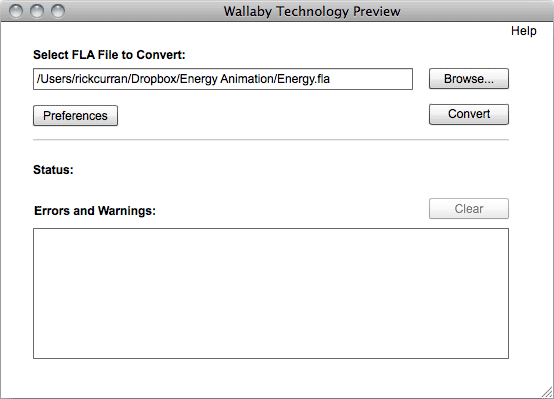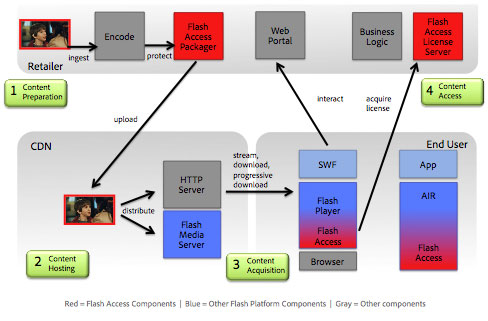Today Adobe published on their Adobe Labs website a public preview of a new application called Edge, which is described in their own words as:
"Adobe® Edge Preview is a new web motion and interaction design tool that allows designers to bring animated content to websites, using web standards like HTML5, JavaScript, and CSS3."
Having previously done a little comparison between the output contents and file size of their previously released Wallaby ‘Flash to HTML5’ conversion tool and that of Flash itself then I thought it would be good to do the same thing for Edge. However, the problem at the moment is – being only the first preview release – Edge has a fairly limited featureset with animation methods such as rotation, location (X / Y axis movement), opacity, scaling and skewing. Essentially some of the basic animation tools that you’d find in Flash. The problem with trying to do a comparison along the lines of the Wallaby test that I did is that I used a shape-tweened animation for that test, something which just isn’t possible at this time within the capabilities of Edge.
So, in lieu of being able to do a really exact comparison I have instead made a simple animation using one of the original SVG source graphics that I used for my Wallaby test. The main outcome of doing this test is just to see what the output of Edge is like – how many files does it create, how big is each file individually and in total. If you haven’t read the previous Wallaby post prior to this then in a nutshell the Flash output was far more efficient in both number of files and file size. Again it has to be said that a shape-tween animation is probably the most complex type of animation you could aim to do in this context, so I did set the bar fairly high there. But as tools like Edge and Wallaby are an attempt to try and bring Flash-esque timeline based animation creation to the world of HTML5/CSS/JS/SVG then it’s fair to expect that beyond some simple x/y movement and rotation that shape-tweening is something that people – especially those from a Flash background – will want to create.
‘Edge Case’ sample: Rotating an SVG in Adobe Edge
So, here’s the simple animation I created in Edge. I imported an SVG file which I had used for the Wallaby test and applied a simple 360 degree rotation to it, a lot simpler than the Wallaby test but I thought it was worthwhile bringing in an SVG file to see what Edge did with it.
View Edge’s Output in new Window
Download the Edge Assets as a Zip
Adobe Edge’s ouput HTML, CSS, JS etc
Here are all the files that Edge created for this example:

- edge-case.html: 1kb
- edge_includes/jquery-1.4.2.min.js: 72kb
- edge_includes/jquery.easing.1.3.js: 8kb
- edge_includes/edge.0.1.1.min.js: 32kb
- edge_includes/edge.symbol.0.1.1.min.js: 29kb
- edge-case_edge.js: 5kb
- edge-case_edge.css: 1kb
- images/noun_project_182.svg: 1kb
Total: 149kb
So, to get that basic rotation animation of an SVG file we get almost a 150kb payload in order to make that work. I haven’t bothered creating a Flash (or video) version of this animation as I think it’s fairly clear that it would be possible to get a smaller file size using Flash to create it. Edge and tools like it have obviously got their work cut out here, especially with the huge use of mobile devices then file sizes and number of separate files in a site (i.e. minimising server calls etc) is an important issue.
We’ve definitely got to cut Edge some slack though here, as small as Flash files can be it’s important to remember that the entire runtime for Flash is a plugin whereas as HTML / CSS / JS etc is supported by the browser’s native features, Also the JS files used by Edge are providing a kind of runtime in the form of some Javascript functions which gets added to every animation that you create with it. Presumably this could be alleviated by having this file be published only once and then referenced, or better yet by being hosted by Google’s CDN and referenced that way along with jQuery which Edge also includes with each animation.
Adobe Edge: Just a tool for Flash-ers or true HTML based creation?
It’s hard to say at this point how these tools will be used, a big area will surely be a replacement for Flash-based interactive / animated advertising, again file size is very important here as Flash banner ads often have a maxmimum payload for ad networks of about 40kb, so Edge is not competitive here.
I think my biggest concern about these tools is that they simply become a swap-in replacement for Flash and that people start to use them purely from a visual perspective and not considering the structure and semantic meaning which underlies all HTML pages. It is *HTML*5 after all, even though that term is often used as a buzzword to include JavaScript effects, technologies such as Canvas, SVG etc. It is extremely important to remember that semantic meaning is at the core of HTML. As such animations created with tools like Edge should keep that at heart and include a workflow that encourages this fact, not just enabling ways to make things move around the screen etc. So I’ll be interested to see how things progress with Edge.
Despite that concern it is still great to see tools like Edge and Sencha Animator being released, the uptake of complex JavaScript based interaction and animation is certainly hindered most by the lack of capable IDE’s to make the process quicker to do. Hand coding jQuery animation and interaction is fine but a good IDE would enable you to keep on top of the code being used but also make it much quicker and efficient to develop using these technologies.
Anyway, that’s my thoughts having played around with Edge, I’ll have to go catch up with some reading online and see what other people are saying, feel free to comment with your own thoughts!











